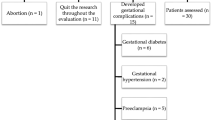Abstract
Levels of thiobarbituric acid reactive substances (TBARS), an indicative parameter for oxidative damage, were measured in maternal and cord arterial and venous bloods, and compared between abdominal and vaginal deliveries. Spontaneous labor resulting in either vaginal or emergency abdominal deliveries was associated with a statistically significant higher levels of TBARS in cord artery compared to cord vein and maternal blood (p<0.05). The results support a role of reactive oxygen species in the initiation of labor, possibly through their effect on prostaglandin metabolism. Alternatively, this may be a marker of fetal oxidative stress, secondary to the process of labor.
Similar content being viewed by others
Author information
Authors and Affiliations
Additional information
Received: February 1998 / Accepted: 8 March 1999
Rights and permissions
About this article
Cite this article
Yaacobi, N., Ohel, G. & Hochman, A. Reactive oxygen species in the process of labor. Arch Gynecol Obstet 263, 23–24 (1999). https://doi.org/10.1007/s004040050255
Issue Date:
DOI: https://doi.org/10.1007/s004040050255




